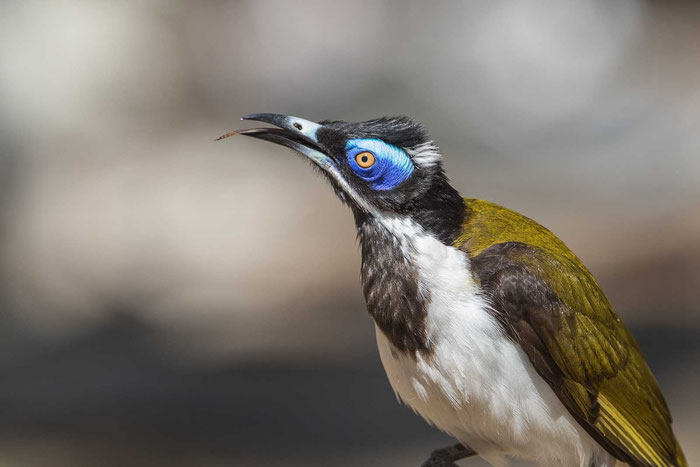Blauohr-Honigfresser
Entomyzon cyanotis, Blue-faced Honeyeater


Der Blauohr-Honigfresser (Entomyzon cyanotis) ist mit seiner blauen Kopffärbung ein sehr auffälliger großer Honigfresser. Die Vögel treten oft in kleinen territorialen Gruppen auf und ernähren sich hauptsächlich von Insekten und Nektar, gelegentlich auch von Früchten. Sie bevorzugen offene und trockene Hartlaubwälder, die von Eukalyptus dominiert sind.
Bildergalerie
Vogelstimmen
Blauohr-Honigfresser sind recht laute Vögel, deren Gesang früh am Morgen einsetzt.
Gesang
Rufe
Quelle und Links
- Eintrag zum Blauohr-Honigfresser im Handbook of the Birds of the World Alive.
- Information zum Blauohr-Honigfresser in der Deutschen Wikipedia.
- Angaben zur Verbreitung des Blauohr-Honigfressers bei Birdlife Australia
- Higgins, P., Christidis, L., Ford, H. & Kirwan, G.M. (2018). Blue-faced Honeyeater (Entomyzon cyanotis). In: del Hoyo, J., Elliott, A., Sargatal, J., Christie, D.A. & de Juana, E. (eds.). Handbook of the Birds of the World Alive. Lynx Edicions, Barcelona. (retrieved from https://www.hbw.com/node/60412 on 9 December 2018).
- Karte: San Jose, 1 April 2007, adapted by Chumwa, 6 May 2008 [GFDL (http://www.gnu.org/copyleft/fdl.html) or CC-BY-SA-3.0 (http://creativecommons.org/licenses/by-sa/3.0/)], via Wikimedia Commons
- BirdLife Australia - Birdata Project http://www.birdata.com.au





